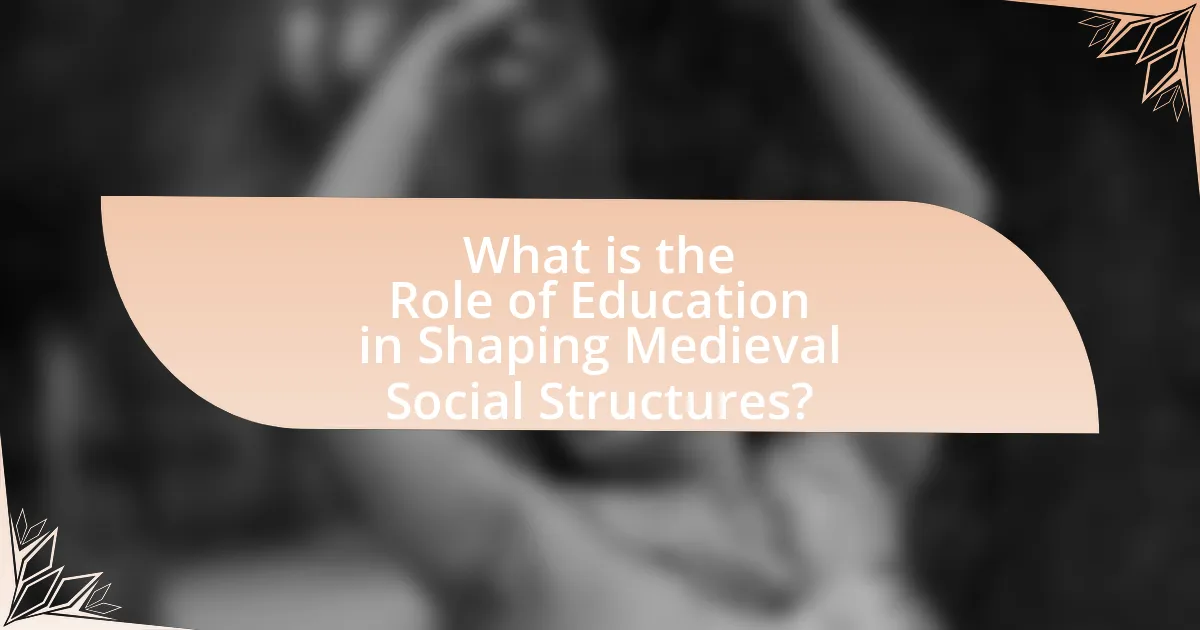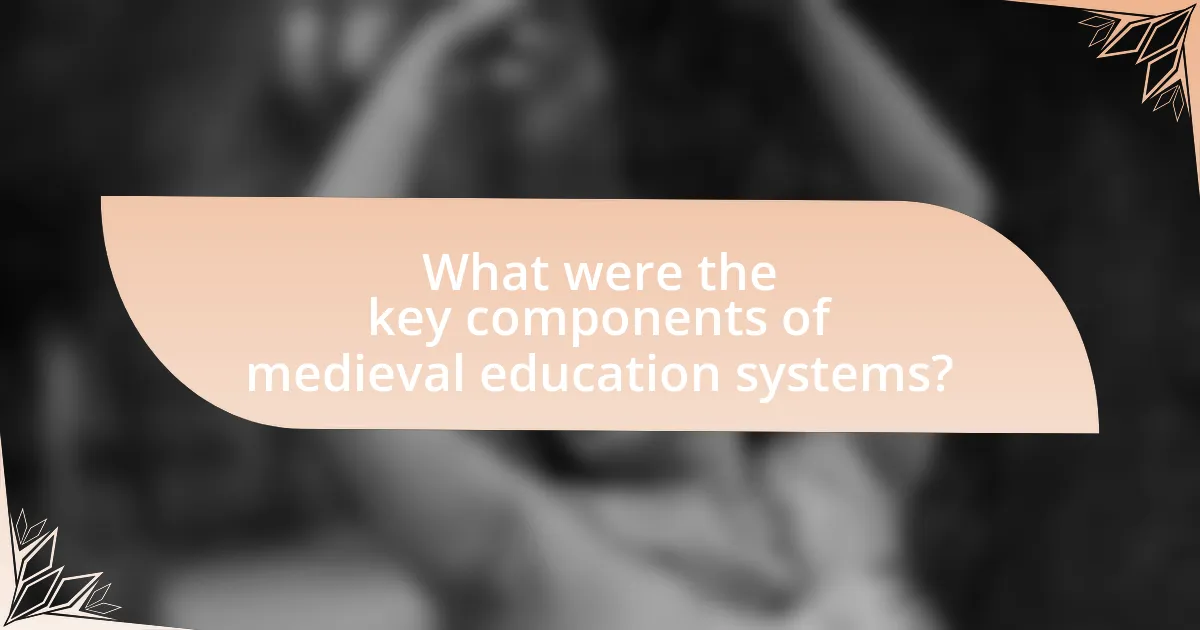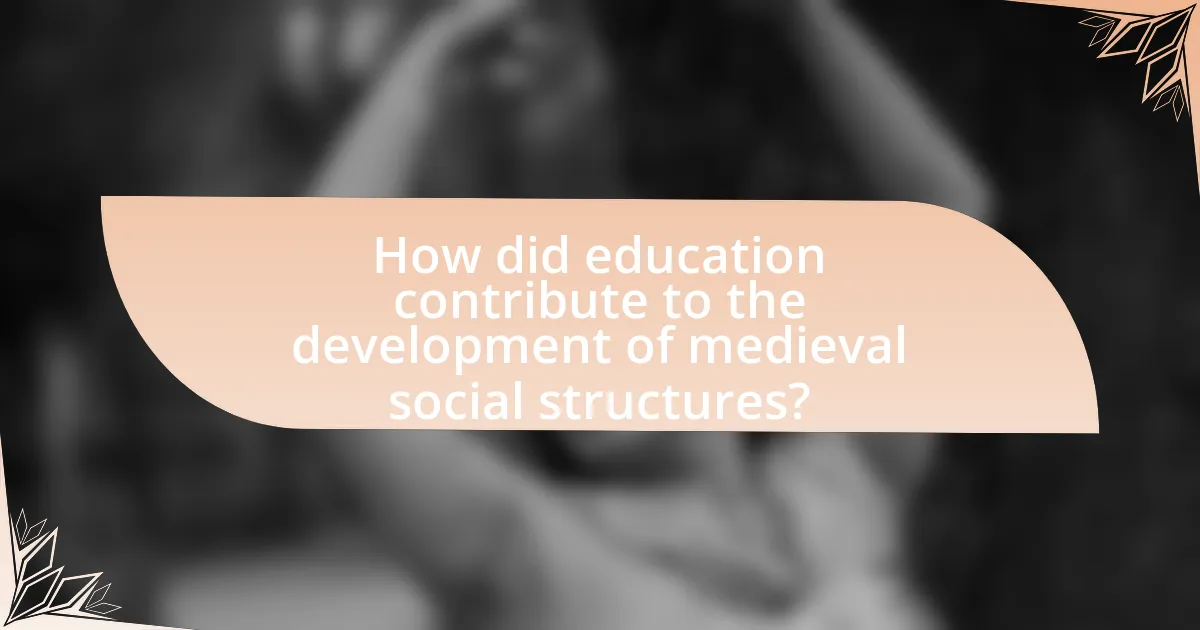The article examines the pivotal role of education in shaping social structures during the medieval period, highlighting how the Church and emerging universities established a hierarchy of knowledge that reinforced social stratification. It discusses the types of education prevalent at the time, including monastic and cathedral schools, and the limited access to education for lower classes, which perpetuated inequalities. The influence of educated individuals on governance and politics, as well as the legacy of medieval education in modern society, are also explored, emphasizing the ongoing impact of educational disparities on social dynamics.

What is the Role of Education in Shaping Medieval Social Structures?
Education played a crucial role in shaping medieval social structures by establishing a hierarchy of knowledge and influence. The Church was the primary institution of education, controlling the curriculum and promoting literacy among the clergy, which in turn reinforced the Church’s authority over society. Monastic schools and cathedral schools educated future leaders, creating a class of literate individuals who could serve in administrative and ecclesiastical roles. This educational framework contributed to the stratification of society, as access to education was largely limited to the elite, thereby perpetuating social inequalities. Historical evidence shows that the rise of universities in the 12th century further solidified this structure, as they became centers of learning that catered to the upper classes, thus shaping the intellectual landscape and social dynamics of medieval Europe.
How did education influence social hierarchies in medieval society?
Education significantly influenced social hierarchies in medieval society by establishing a clear distinction between the educated elite and the uneducated masses. The clergy and nobility, who had access to formal education, often held positions of power and authority, reinforcing their social status. For instance, the Church controlled educational institutions, which allowed clergy members to dominate intellectual life and governance, thereby perpetuating their influence over societal norms and values. Additionally, the rise of universities in the 12th century further solidified the divide, as they primarily served the upper classes, creating a learned elite that was distinct from the peasantry. This educational disparity contributed to the entrenchment of social stratification, as knowledge became a tool for maintaining power and privilege within the upper echelons of society.
What types of education were prevalent during the medieval period?
During the medieval period, the prevalent types of education included monastic education, cathedral schools, and the emerging universities. Monastic education focused on religious instruction and literacy, primarily aimed at training clergy, while cathedral schools provided a broader curriculum that included the liberal arts for future church leaders. The establishment of universities in the 12th century marked a significant development, offering advanced studies in theology, law, medicine, and the arts, thus shaping the intellectual landscape of the time. These educational institutions were crucial in preserving knowledge and fostering scholarly activity, which played a vital role in the social structures of medieval society.
How did access to education vary among different social classes?
Access to education in medieval society varied significantly among different social classes, with the nobility and clergy having the greatest access, while peasants and lower classes faced substantial barriers. Nobles often had private tutors and attended cathedral schools, which provided a comprehensive education, including Latin, philosophy, and theology. In contrast, the majority of peasants received little to no formal education, primarily learning practical skills necessary for agricultural work. Historical records indicate that by the 12th century, only a small percentage of the population, primarily from the upper classes, could read and write, highlighting the stark educational divide.
Why was education considered essential for social mobility in medieval times?
Education was considered essential for social mobility in medieval times because it provided individuals with the knowledge and skills necessary to advance in society. During this period, access to education was primarily available through religious institutions, which taught reading, writing, and arithmetic, enabling individuals to take on roles in administration, the clergy, or skilled trades. The ability to read and write was particularly valuable, as it opened opportunities for positions that required literacy, such as clerks or notaries, which were often gateways to higher social status. Historical evidence shows that individuals who received education could improve their economic standing and influence, as seen in the rise of the merchant class and educated clergy who gained power and wealth through their knowledge and connections.
What role did the Church play in the education system?
The Church played a central role in the education system during the medieval period by establishing schools and universities that were primarily focused on religious instruction. These institutions were often the only sources of education available, as the Church sought to educate clergy and laypeople in theology, philosophy, and the liberal arts. For instance, the University of Paris, founded in the 12th century, was heavily influenced by the Church and became a leading center for theological studies. Additionally, monastic schools, such as those run by Benedictine monks, provided education to boys and young men, emphasizing literacy and religious texts. This educational framework not only reinforced the Church’s authority but also shaped the intellectual landscape of medieval society, as the Church was the primary custodian of knowledge and learning during this era.
How did universities emerge as centers of learning and influence?
Universities emerged as centers of learning and influence primarily during the 12th century, evolving from cathedral schools and monastic institutions that focused on religious education. These early universities, such as the University of Bologna and the University of Paris, began to offer a broader curriculum that included the liberal arts, law, medicine, and theology, attracting scholars and students from various regions. The establishment of charters and the recognition of academic freedom further solidified their status, allowing them to operate independently and become influential in shaping intellectual thought and societal norms. By the late Middle Ages, universities had become pivotal in the dissemination of knowledge, contributing to the rise of humanism and the eventual transition to the Renaissance.

What were the key components of medieval education systems?
The key components of medieval education systems included the church, universities, and the curriculum focused on the trivium and quadrivium. The church served as the primary institution for education, providing religious instruction and literacy training, which was essential for clerical positions. Universities emerged in the 12th century, such as the University of Bologna and the University of Paris, offering advanced studies and degrees. The curriculum was structured around the trivium (grammar, rhetoric, and logic) and the quadrivium (arithmetic, geometry, music, and astronomy), forming the foundation of higher learning. These components collectively shaped the educational landscape and influenced social hierarchies during the medieval period.
What subjects were taught in medieval educational institutions?
Medieval educational institutions primarily taught subjects such as grammar, rhetoric, logic, arithmetic, geometry, music, and astronomy, collectively known as the liberal arts. These subjects formed the foundation of education in medieval universities, which emerged in the 12th century, emphasizing a curriculum that prepared students for various professions, including theology, law, and medicine. The focus on the liberal arts was rooted in classical education, reflecting the influence of ancient Greek and Roman scholarship, which aimed to cultivate critical thinking and effective communication skills.
How did the curriculum reflect the values of medieval society?
The curriculum in medieval society reflected its values by emphasizing religious instruction, classical knowledge, and moral education. This focus on theology and philosophy underscored the central role of the Church in daily life and governance, as seen in the establishment of cathedral schools and universities that prioritized subjects like Latin, scripture, and ethics. Additionally, the inclusion of classical texts from authors such as Aristotle and Cicero illustrated the value placed on reason and civic responsibility, aligning with the feudal system’s hierarchical structure. The curriculum’s design aimed to cultivate not only educated clergy but also informed laypeople who could contribute to the moral and social order of the time.
What methods were used to teach students during this period?
During the medieval period, the primary methods used to teach students included lectures, discussions, and the Socratic method. Lectures involved instructors presenting material to students, often using texts as a basis for discussion. The Socratic method encouraged critical thinking through dialogue, prompting students to ask questions and engage in debates. Additionally, apprenticeships and hands-on training were common in vocational education, allowing students to learn trades directly from skilled artisans. These methods were essential in shaping the educational landscape and social structures of the time, as they facilitated the transfer of knowledge and skills necessary for various societal roles.
How did the structure of educational institutions impact social structures?
The structure of educational institutions significantly influenced social structures by establishing hierarchies and facilitating social mobility. In medieval Europe, the Church and universities became central to education, creating a system where knowledge was concentrated among the clergy and educated elites. This concentration of knowledge reinforced social stratification, as access to education was limited to certain classes, primarily the nobility and clergy, thereby perpetuating their power and influence in society.
For instance, the establishment of universities in the 12th century, such as the University of Bologna and the University of Paris, formalized education and created a distinct class of educated individuals who held positions of authority in both religious and secular realms. This educational framework not only solidified existing social hierarchies but also provided pathways for individuals from lower classes to ascend socially through education, albeit in limited numbers.
The impact of educational institutions on social structures is evident in the way they shaped the roles of different social classes, with educated individuals often becoming advisors, administrators, and leaders, thus reinforcing the power dynamics of the time.
What was the relationship between guilds and education?
Guilds played a significant role in education during the medieval period by providing structured training and apprenticeship programs for skilled trades. These organizations established standards for craftsmanship and ensured that apprentices received comprehensive instruction from experienced masters, which was essential for maintaining quality and expertise within various trades. Historical records indicate that guilds often required apprentices to complete a certain number of years of training before they could become journeymen or masters themselves, thereby formalizing the educational process within the context of vocational training. This relationship between guilds and education not only facilitated the transfer of knowledge and skills but also contributed to the social and economic stability of medieval communities by ensuring a skilled workforce.
How did the rise of secular education challenge traditional norms?
The rise of secular education challenged traditional norms by promoting knowledge and learning independent of religious institutions. This shift allowed for the development of critical thinking and inquiry, which often contradicted established religious doctrines. For instance, the establishment of universities in the 12th century, such as the University of Bologna and the University of Paris, emphasized a curriculum based on reason and empirical evidence rather than solely on theological teachings. This educational transformation led to a questioning of authority and the emergence of new philosophical ideas, ultimately contributing to the decline of the Church’s dominance in intellectual life during the medieval period.

How did education contribute to the development of medieval social structures?
Education significantly contributed to the development of medieval social structures by establishing a hierarchy based on knowledge and literacy. In medieval Europe, the Church was the primary institution responsible for education, which led to the clergy becoming a distinct social class with considerable influence over both spiritual and temporal matters. The establishment of universities in the 12th century further solidified this structure, as they became centers of learning that produced educated elites who often occupied positions of power in government and society.
For example, the University of Bologna, founded in 1088, became a model for higher education and attracted students from various regions, thereby creating a network of educated individuals who could navigate and influence the social order. This educational framework not only reinforced existing hierarchies but also facilitated the emergence of new social classes, such as the bourgeoisie, who gained prominence through trade and commerce, often supported by their education. Thus, education was a crucial factor in shaping the complex social dynamics of the medieval period.
What impact did education have on the roles of different social classes?
Education significantly influenced the roles of different social classes in medieval society by providing access to knowledge and skills that were essential for social mobility and the exercise of power. The clergy, who were often the most educated, gained authority and influence due to their literacy and ability to interpret religious texts, which positioned them as spiritual leaders. In contrast, the nobility utilized education to manage their estates and engage in governance, thereby reinforcing their social status. Meanwhile, the peasantry had limited access to education, which restricted their opportunities for advancement and maintained their subordinate position in the social hierarchy. Historical evidence shows that the establishment of universities in the 12th century further entrenched these roles, as they primarily served the elite, thereby widening the gap between social classes.
How did educated individuals influence governance and politics?
Educated individuals significantly influenced governance and politics by providing the intellectual foundation for administrative and legal systems. In medieval Europe, for instance, clergy and scholars often held positions of power, advising monarchs and shaping policies based on their knowledge of law, philosophy, and theology. The establishment of universities in the 12th century further empowered educated elites, as they became key players in the development of political thought and governance structures. Their writings, such as those by Thomas Aquinas, integrated Aristotelian philosophy with Christian doctrine, influencing political theory and the justification of authority. This intellectual engagement helped to legitimize and structure governance, demonstrating the critical role of educated individuals in shaping political landscapes.
What was the significance of literacy in shaping social interactions?
Literacy significantly shaped social interactions by facilitating communication, knowledge dissemination, and social mobility. In medieval societies, the ability to read and write allowed individuals to engage in legal, religious, and administrative matters, thus enhancing their social standing and influence. For instance, literate individuals could participate in the creation of legal documents, which were essential for trade and governance, thereby establishing their roles as key players in their communities. Historical evidence shows that literacy rates among the clergy and emerging merchant classes contributed to the development of towns and the rise of a more complex social structure, as documented in studies like “The Rise of Literacy in Medieval Europe” by David C. Douglas. This underscores the critical role literacy played in transforming social dynamics during the medieval period.
How can we see the legacy of medieval education in modern society?
The legacy of medieval education is evident in modern society through the establishment of universities and the emphasis on liberal arts. Medieval education laid the groundwork for higher learning institutions, with the first universities emerging in the 12th century, such as the University of Bologna and the University of Paris. These institutions focused on a curriculum that included grammar, rhetoric, logic, arithmetic, geometry, music, and astronomy, which are foundational elements of the liberal arts education still prevalent today. Furthermore, the medieval emphasis on scholasticism and critical thinking has influenced contemporary educational practices, promoting analytical skills and a structured approach to learning.
What lessons can contemporary education systems learn from medieval practices?
Contemporary education systems can learn the importance of community involvement and mentorship from medieval practices. In medieval times, education was often a communal effort, with local guilds and religious institutions playing significant roles in teaching skills and values. This collaborative approach fostered strong social bonds and ensured that education was relevant to the community’s needs. For instance, the establishment of universities in medieval Europe, such as the University of Bologna in 1088, emphasized the role of collective learning and mentorship, where experienced scholars guided students in a supportive environment. By integrating community engagement and mentorship into modern education, contemporary systems can enhance student learning and social cohesion.
How does understanding medieval education enhance our view of social structures today?
Understanding medieval education enhances our view of social structures today by illustrating how educational systems were intertwined with social hierarchies and power dynamics. In medieval Europe, education was primarily accessible to the elite, reinforcing class distinctions and limiting social mobility. For instance, the establishment of universities in the 12th century, such as the University of Bologna, catered predominantly to the nobility and clergy, thereby shaping a social structure that privileged certain groups over others. This historical context allows us to recognize parallels in contemporary education systems, where access to quality education often reflects socioeconomic status, thus perpetuating existing inequalities. By analyzing these patterns, we gain insight into how education continues to influence social stratification in modern societies.
What practical insights can be drawn from the role of education in medieval society?
Education in medieval society primarily served to reinforce social hierarchies and facilitate the transmission of knowledge among the elite. The establishment of universities in the 12th century, such as the University of Bologna and the University of Paris, exemplified how education became a tool for the clergy and nobility to maintain their power and influence. These institutions focused on subjects like theology, law, and medicine, which were essential for governance and religious authority, thereby ensuring that educated individuals were aligned with the interests of the ruling class. Furthermore, the limited access to education for the lower classes highlighted the societal divide, as literacy and learning were predominantly reserved for those of higher social standing, thus perpetuating existing inequalities.